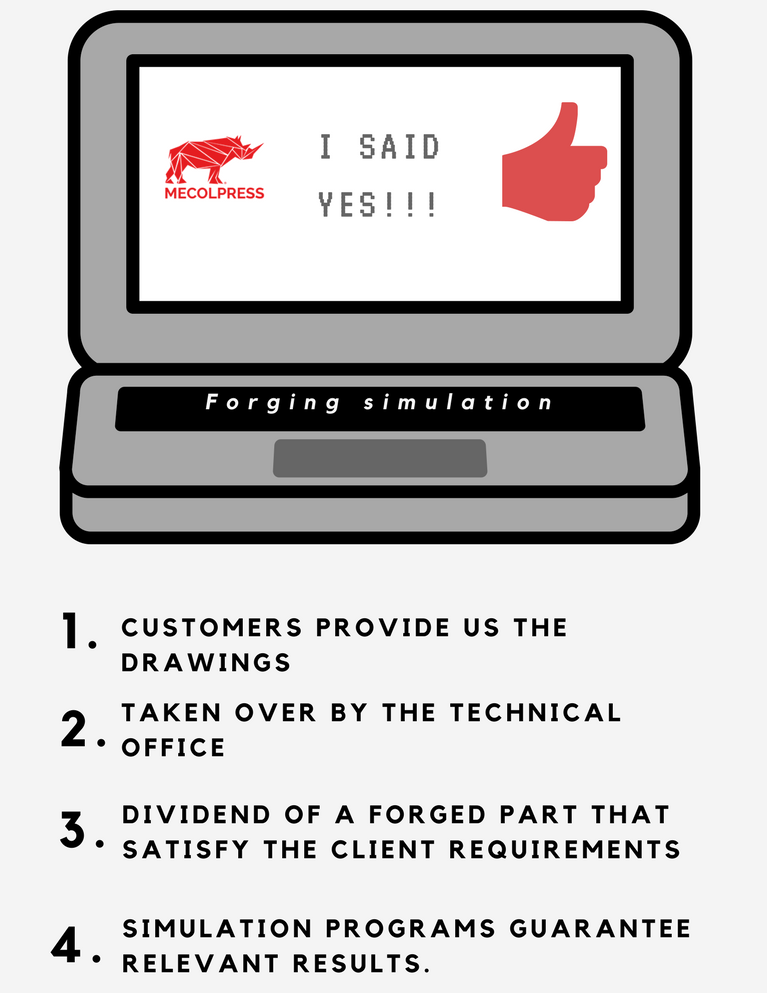
Forging simulation
Mecolpress sells turn-key forging plants.
This means to offer to the customer not only reliable and innovative machines, but competence on the forging product and process as well: the forging line has to work regularly, respecting the productivity level and granting stable quality. During the proposal phase, the careful evaluation of the parts to be forged is always a crucial element.
Traditionally, this activity was limited to the knowledge acquired thanks to many years of experience of a few key persons, so the evaluation of the parts was based on their “memory”, trying to remember the difficulties or solution identified in the past on similar parts. Precise technical parameters and data were seldom available and recorded, and therefore the surprises during the dies real tests were very frequent, in particular the forging forces were unknown and heavily influencing the final acceptance test of the machine.
Since the work flow programming is becoming more and more important to respect the planned delivery time and, at the end, to match the yearly turnover goals, the possibility to precisely foresee and plan the final activities of the forging line manufacturing is a key factor. Mecolpress since already five years use a hot forging simulation software that allows to analyse in the technical office the flow of the material in the die, and in this way to carry out a “virtual pre-acceptance” of the forging equipment. The goal is to anticipate as much as possible the forging difficulties and, to a higher level, to share among a wider number of persons and departments, the forging process knowledge: the aim is to go from “workshop expert man” to “forging mathematics”. For the sales department as well, this methodology brings clear advantages: the possibility to demonstrate in a transparent and easy-to-understand way the technical reasons on which the die design and identification of the suitable machine are based, is often a winning element to involve the customer in the project definition and in the last phases of the negotiation.

Usually the choice of the machine and the die design phases respect a standard sequence of steps:
- first, the customers provide us with the drawings of the forged and/or of the machined part,
- the Mecolpress sales personnel choose the most difficult or doubt ones and give these to the technical office.
- From this moment onward, subsequent FEM analysis are carried out, eventually suggesting as well to the customer modifications of details of the part, to reach the result of a forged piece that satisfy the (final) customer requirements and can be forged without defects thanks to the Mecolpress technology.
- The forging simulation software has been programmed with the Mecolpress machines specific dynamic characteristics and grant therefore highly reliable results.
After the die has been manufactured, the real forging phases in the production departments start.
Tthe first thing to do is to share the project parameters and machine program data between the technical office and the dies test department.
It is now that it is essential to understand if, and eventually how, the real behaviour of the material is deviating from the expected path, and to this extent the hydraulic forging machines have a special production cycle called “simulation steps” to produce several parts with pre-programmed partial completion steps, in particular with different cores penetration depths.
If this process is well managed and used, it easily lead to verify what foreseen in the computerized simulation, and also to identify the source of defects that might be found later in the finished parts, even in areas that are not easy to be seen at first sight.
Once the dies have been successfully tested in the production dept., the customer participate to the forging line final acceptance and can examine the forging process as proposed in the offer and agreed in the order.
To have anticipated the analysis of the piece and to share the forging process knowledge among the engineers of the technical office has reduced the variability of the length of the real tests duration and has brought to a much more precise and reliable calculation of the lead time of the machine in general.

